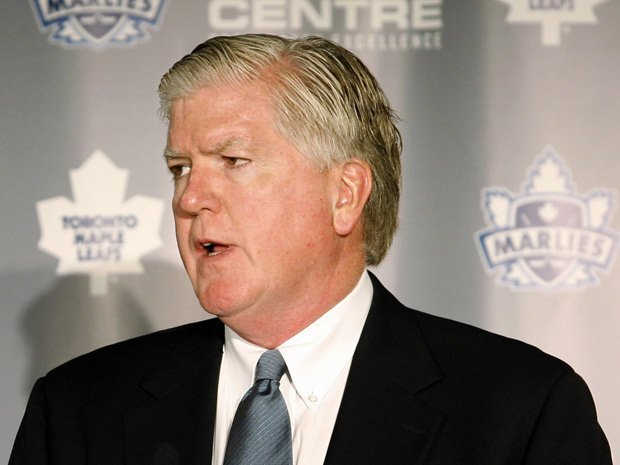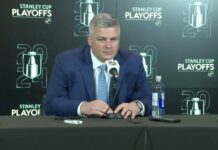
It seems that a large percentage of Leafs Nation is completely convinced that the team they saw in February and March of the 2011-12 season is the true reflection of the roster’s ability. Many have completely disregarded the 99-point pace the team played at for the entire 2011 calendar year and beyond, right up until February 6th of 2012.
This skepticism is not undeserved. The team completely collapsed after that victory over the Oilers in early February that saw the Leafs three regulation wins ahead of the eventual Cup-winning Los Angeles Kings. What followed that victory was one of the worst stretches in the entire history of the franchise. As a result, the fans have decided that a massive roster overhaul is necessary. Now well into the summer, they grow increasingly agitated with each day that passes and does not bring line-up changes.
It is not my intention to try and persuade Leaf fans to get their blue and white goggles back out and start drinking the Kool-Aid again. It is also not my intention to act as a Burke apologist. The Maple Leafs are not a great team, and they do have a long way to go before turning things around in a meaningful way. However, perhaps it would be wise for the fan base—s collective sanity to reel in some of the pessimism and look at some of the reasons that the playoff drought, the embarrassment, and the general mediocrity may be coming to an end within the next couple of seasons.
Where Are We?
In order to know where we need to go, we must first establish where we are. Now of course I expect that most Leaf fans have already grown irate reading a question that has an answer they deem to be painfully obvious. The common rhetoric of the summer has been that the Leafs are a lottery team – now and in the foreseeable future – and one of the only teams in the Eastern Conference yet to significantly upgrade their roster. Fair enough. In my opinion, if you actually look at the league-wide movement thus far this summer, this is a false notion, but I understand the pessimism and anxiety.
There is no doubt that one can look at the standings and determine that the team is in a bad way. However, if we try to share Brian Burke—s post-season assessment of the club, we are reminded that even though the ultimate result was negative, we cannot ignore the fact that pieces have been put in place for the future. After all, Kessel, Lupul, Grabovski, Phaneuf, Gardiner — these are desirable players who one could easily imagine succeeding with a stronger supporting cast. With that in mind, let us try to imagine what the roster might look like in 2-3 seasons:
| FORWARDS | ||
| Van Riemsdyk | Kessel | |
| Lupul | Grabovski | |
| Kulemin | Kadri/Colborne | Frattin/Biggs |
| Devane/Broll | McClement | D’Amigo/Ashton |
| Crescenzi, Ross, McKegg |
| DEFENCE |
|
| Phaneuf | |
| Rielly | Gardiner |
| JM Liles, Percy, Finn | Holzer, Blacker |
| Fraser | Granberg |
| GOALTENDING | |
| Reimer | Scrivens |
| Owuya | Sparks |
Bold: All but locked into a long-term roster
The above graphic shows what I believe to be the bare minimum of what the team has in its arsenal for the future of 2-3 years from now. That is to say, I feel that we can expect that Kadri and Colborne will at the very least become top nine centers; that Frattin and Biggs will at the very least become top nine wingers, and so on and so forth. In terms of the italicized prospects, this is a fairly conservative set of expectations. No one is counting on Kadri to become a 90 point player, or Frattin to be a 40 goal scorer. It doesn—t mean it won—t or can—t happen, just that no one is expecting it.
That said, there are still debatable aspects of this graphic. For example, you may not feel that James VanRiemsdyk is a legitimate top line left winger. He may not be, but he should be able to succeed in that spot regardless. Most top lines are composed of two elite players and one lesser player. Similarly, perhaps it—s a tad too soon to appoint Rielly a guaranteed top four NHL defender within 2-3 years. However, given his pedigree, and the positive reviews from around the league so far, I think it—s safe to move forward on the assumption that the Leafs drafted at the very least, a top four defender with a 5th overall draft selection.
Assuming we can put aside the semantic differences of opinion in regards to future roster brackets depicted here, lets break down what we actually have:
Glaring Weaknesses
The first thing you notice here is that the Leafs are missing several of the most crucial pieces of a roster. This is not news, I realize, but discussing it is hard to avoid. It—s possible that one of the goalies in the system could grow into that gaping blank — Reimer especially has shown flashes, and he—s still very young. Likewise, Colborne or Kadri could easily move up the roster and Frattin and/or Biggs may be top six material. From a bare minimum perspective though, the Leafs are short a top line center, a top six forward (preferably one with size, heart, leadership and toughness), a top defender to partner with Dion Phaneuf, and a legitimate starting goalie. Tall task, but not as insurmountable and hopeless as it probably seems. Here—s why:
NHL Caliber Prospect Depth
The pessimist looks at the above roster graphic and sees what is missing, but the optimist might look at it and see a lot of potential and depth coming up in the form of prospects. If there is one thing Burke has done a particularly good job of during his tenure in Toronto, it is accumulating quality depth. I believe that all of the players listed above will probably have NHL careers of some kind. That may not sound like a ringing endorsement of the teams— prospects, but the reality is that just being an NHL caliber asset has significant and often under-appreciated value.
Look no further than the very recent Rick Nash trade. New York gave up a hand full of assets to acquire the star winger, but nothing incredibly difficult to come by or develop internally. Dubinsky has scored at a pace of 0.54 points-per-game through the first five seasons of his NHL career. Anisimov has scored at a 0.44 points-per-game pace throughout his young career. Extrapolating this data, one could reasonably expect an average of 44 points from Dubinsky and 36 points from Anisimov over a full season. These are decent young players with some salvageable upside, but clearly nothing extravagant. These guys are not likely to become premier talents, but they—re also not likely to fall out of the league and become worthless.
These are the kinds of assets the Leafs are trying to develop in the likes of Kadri, Colborne, Frattin, Ashton and so forth. Fans tend to get hung up on trying to figure out whether or not individual prospects have ˜blue chip— appeal, but this is probably an inefficient way of evaluating the system. Of course it would be nice if a couple of these guys made Burke—s job easier and just developed into one of the roster—s missing pieces, but it—s not necessary for the Leafs to be moving in the right direction. So long as the Leafs are developing decent NHL players at a steady rate, trades will open themselves up as time rolls along. The more happy surprises we have (like Gardiner, for example) the faster the process will go, but the important thing is that the system is creating NHL players.
Discarded Players
You might also notice that some pretty solid roster players are absent from the above projection. Up front, Tyler Bozak and Clarke MacArthur are gone. On the back end, Carl Gunnarsson and Cody Franson have disappeared. These are quality players that can help a team win, but they happen to be in positions that the Leafs are likely to be able to fill from within at more affordable rates. These four are likely to make pretty strong trade assets.
The hugely unpopular trio of Komisarek, Connolly and Lombardi have also vanished. Avoiding disagreements about whether these players are move-able in trades or whether Burke would subject those eligible to waivers, we can all agree that none of them are likely to merit extensions, and will be gone by the time this team is ready to be a more serious competitor in the East. Burke may or may not be able to recoup picks or prospects for them, but we can probably assume that if they are moved the return will be negligible.
Trade Packages
Here we come to the heart of the matter, and the reason the Leafs are going to be able to make strides at some point in the near future. Using a combination of the players that it looks like they—ll have to inevitably discard (Bozak, MacArthur, Gunnarsson, Franson), the abundance of NHL caliber prospect depth (Kadri /Colborne, Frattin/Biggs, Percy/Finn, Reimer/Scrivens), plus, when the time is right again, futures, the Leafs will be able to put together two or three pretty impressive packages, and should be able to snag another couple of key pieces.
For example:
1.) MacArthur, Gunnarsson, Kadri, Draft Choice
2.) Bozak, Franson, Frattin, Draft Choice
These are both significant packages that, in my opinion, are equal to or better than what it took to acquire Nash. Certainly, they are at the very least in the same ball park. The Leafs are poised to use their depth to step forward.
Some will ask what makes the Leafs special in this regard. It—s a good question. There are quite a few teams with a quality system that routinely develops reliable, if unspectacular, NHL talent. The only answer to this is that the fans will have to have a little faith that Brian Burke can win a bidding war or two at some point. I am sure that his rapidly eroding public reputation is not helping him gain leverage in trade negotiations, but Burke has proven to be a clever tradesman when the chips are down.
Outlook
At the end of the day, more patience is still required. It may not be popular, but Leaf fans need to stop over-reacting to each and every league-wide roster decision and concluding that Burke ˜doesn—t care—, or is ˜asleep at the wheel— or any other nonsense. Mistakes have been made, without doubt, but the solutions are still a little ways off. The fruits of Burke—s labors in trying to strengthen the system on the whole should become apparent this coming season. That should open the door for a significant acquisition.
In the meantime, the uncertainty of a new CBA has likely bogged down attempts at making more immediate alterations. Ultimately, I would suggest that in the coming seasons, Leaf fans may witness a snowball effect not unlike what Los Angeles and Chicago recently experienced. One good trade may push the roster forward, attract an unrestricted free agent or two, which would allow the flexibility to trade futures for more help. This would only serve to reverse the massively negative media slant Toronto faces and allow prospects to suddenly bloom in a more beneficial environment. Everything would and could come together seemingly all at once, but really, this is a process that started a long time ago. This is the event Burke has been trying to craft. Leaf fans are reading a book about an upward struggle; a long, uphill battle. But, they—re ready to close the book two chapters before the protagonist gets his act together. Keep reading¦


![Jim Montgomery Post Game, Bruins 4 vs. Leafs 2: “[Marchand] still manages to get under people’s skin, yet he doesn’t cross the line” Jim Montgomery, Boston Bruins post game](https://mapleleafshotstove.com/wp-content/uploads/2024/04/jim-monty-pg-to-218x150.jpg)























![Jim Montgomery Post Game, Bruins 4 vs. Leafs 2: “[Marchand] still manages to get under people’s skin, yet he doesn’t cross the line” Jim Montgomery, Boston Bruins post game](https://mapleleafshotstove.com/wp-content/uploads/2024/04/jim-monty-pg-to-100x70.jpg)







